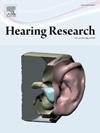Reply to Manley: Is there more to cochlear tuning than meets the ear?
IF 2.5
2区 医学
Q1 AUDIOLOGY & SPEECH-LANGUAGE PATHOLOGY
引用次数: 0
Abstract
Enhanced psychophysical and cochlear tuning observed in musicians is unlikely to be explained by mere differences in human cochlear length. A parsimonious account of our 2016 data is improved efferent feedback from the medial olivocochlear efferent system that adjusts masking and tuning properties of the cochlea and is subject to attentional modulation—all functions reported to be enhanced in musically trained ears. Still, new experiments are needed to tease out “nature” vs. “nurture” effects in music-related brain plasticity and move beyond cross-sectional studies and definitions of “musicians” based solely on self-report.
回复曼利:耳蜗调音是否比耳朵听到的更多?
在音乐家身上观察到的心理物理和耳蜗调谐能力的增强不太可能仅仅用人类耳蜗长度的差异来解释。2016年数据的一个合理解释是,内侧耳蜗传出系统的传出反馈得到了改善,该系统可调整耳蜗的掩蔽和调谐特性,并受注意力调节的影响--据报道,所有这些功能在受过音乐训练的耳朵中都得到了增强。尽管如此,我们仍需要新的实验来揭示与音乐相关的大脑可塑性中的 "自然 "与 "培养 "效应,并超越横断面研究和仅基于自我报告的 "音乐家 "定义。
本文章由计算机程序翻译,如有差异,请以英文原文为准。
求助全文
约1分钟内获得全文
求助全文
来源期刊

Hearing Research
医学-耳鼻喉科学
CiteScore
5.30
自引率
14.30%
发文量
163
审稿时长
75 days
期刊介绍:
The aim of the journal is to provide a forum for papers concerned with basic peripheral and central auditory mechanisms. Emphasis is on experimental and clinical studies, but theoretical and methodological papers will also be considered. The journal publishes original research papers, review and mini- review articles, rapid communications, method/protocol and perspective articles.
Papers submitted should deal with auditory anatomy, physiology, psychophysics, imaging, modeling and behavioural studies in animals and humans, as well as hearing aids and cochlear implants. Papers dealing with the vestibular system are also considered for publication. Papers on comparative aspects of hearing and on effects of drugs and environmental contaminants on hearing function will also be considered. Clinical papers will be accepted when they contribute to the understanding of normal and pathological hearing functions.
 求助内容:
求助内容: 应助结果提醒方式:
应助结果提醒方式:


